Astroloba genus
Astroloba Uitewaal
Family: Asphodelaceae
Common names: astrolobas, starlobes (Eng.); astrolobas, kleinaalwyne, koedoekos, steekaalwyntjies (Afr.)
Introduction
Astrolobas are aloes in the miniature and well adapted to their arid karroid environments. They form clusters of stems that are densely packed with small, sharp, hard succulent leaves, which can have a variety of textures and surface ornamentation. The arrangement of their leaves weave beautiful spiral patterns, while their tiny tubular flowers vary in shape and colour. Because of these characters, they are increasingly utilised as container plants, rockery ornamentals, and even as sought after subjects in specialist collections.

Fig. 1. A healthy specimen of Astroloba spirella, in a nurse plant east of Ladismith. Photo by S.M. Molteno.
Description
Description
Astrolobas are small, stem-forming, generally erect to leaning or even creeping, perennial, leaf succulents. Plants divide from the base to form small to large clusters, of which the central, oldest plants sometimes die off to yield a fairy ring-like arrangement. Stems can reach a length of about 0.5 m and, especially lower down, are covered in the remains of dead leaves, while the leaves in the upper part of a stem are green.
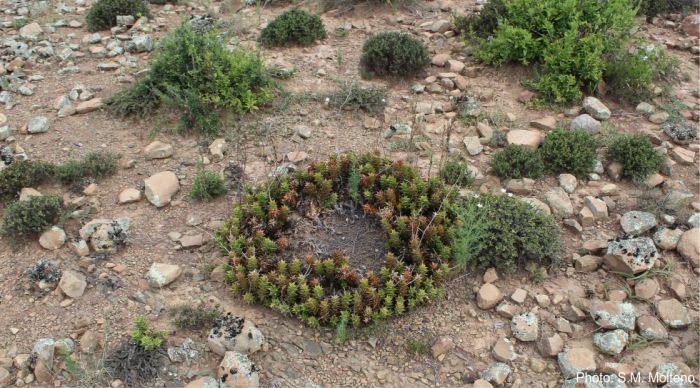
Fig. 2. Older astroloba specimens can sometimes develop a ‘fairy ring-like’ growth form, especially in cases where the nurse plant has died. Photo by S.M. Molteno.
New leaves emerge at the apical growth point of a stem, in a basic growth spiral (the generative spiral) that can be either clockwise or anticlockwise on each stem. As a result of the consistent angle between consecutive leaves on the stem of a plant (the divergence angle), the resulting leaf arrangement along a stem tends to form a pattern of (usually five) secondary leaf ranks or spirals. The divergence angles of different plants give rise to different spiral patterns (phyllotaxis).
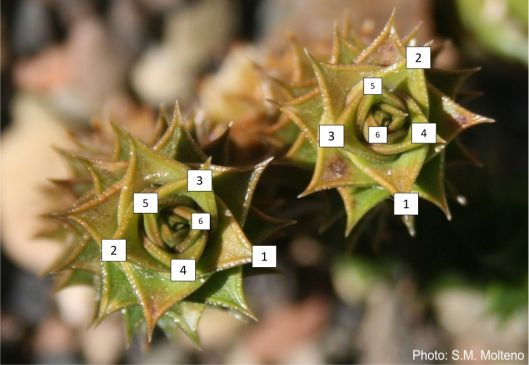
Fig. 3. Astroloba leaves emerge around the central growth point in a regular spiral arrangement. This is known as the generative spiral, and it can be clockwise or anticlockwise at random. To show this, some of the leaves on these two stems (of the same Astroloba foliolosa specimen) have been numbered, according to their order of emergence. Photo by S.M. Molteno.
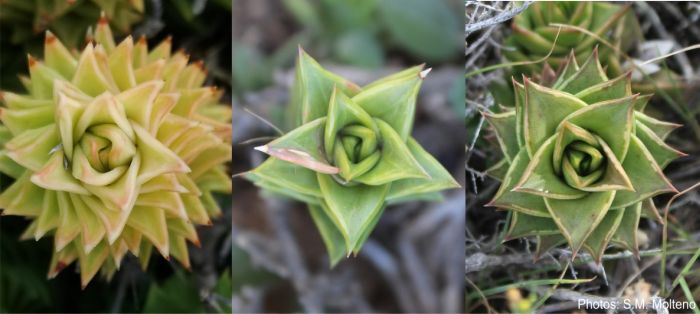
Fig. 4. These stems have generative spirals that go in the same direction (anticlockwise viewed from above). However, differences in the divergence angle, between two consecutive leaves, can lead to the five leaf ranks either spiralling in the same direction as the generative spiral (left); forming vertical ranks (centre); or spiralling in the opposite direction to the generative spiral (right). This is a very useful diagnostic character for astrolobas. Photos by S.M. Molteno.
The leaves are keeled, triangular, hard, and sharp-tipped. Leaf colour varies from various shades of green to bluish green to brownish, often with darker longitudinal stripes. Leaf texture is variable, ranging from smooth and shiny to rough and distinctly tuberculate, with a distinct, asymmetric keel. The leaf margins are usually smooth, but could also be finely toothed or tuberculate. In some species the margin loses its identity below the leaf tip.

Fig. 5. Variation in astroloba leaf ornamentation is demonstrated by the large, transversely arranged tubercles of the Astroloba bullulata specimen (left); the minute asperous tubercles of Astroloba corrugata (centre); and the longitudinal striations of the Astroloba pentagona specimen (right). Photos by S.M. Molteno.
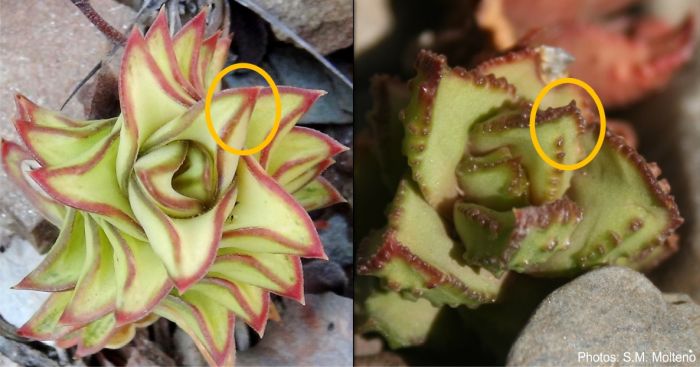
Fig. 6. On some astrolobas, such as the Astroloba bullulata specimen on the right, one of the margins of each leaf lost its identity before the leaf tip. Photos by S.M. Molteno.
Inflorescences, which can reach a length of 0.6 m, carry the often widely spaced flowers in a raceme, which can rarely be branched. Pedicel (flower stalk) length is variable. In some species it is short, so making the inflorescences appear spike-like. The regular, tubular flowers are borne erectly or at least slanted upwards. In some species the perianth is longitudinally adorned with smooth or ruffled inflated tissue. The colour of the perianth (flower) lobes is variable. However, with one red-flowered exception (Astroloba rubriflora), the perianth tube is drab- to dull-coloured. Plants usually flower only once per year.

Fig. 7. The genus Astroloba has more floral diversity than any other alooid genus except for Aloe itself. The examples are, clockwise from the top left corner of the image: A. tenax, A. herrei, A. spiralis, A. rubriflora, A. spirella, and A. robusta. Photos by S.M. Molteno.
The morphological characters that define Astroloba are mostly its short, narrow stems; small, hard, sharp-tipped, more or less short-triangular leaves; the leaves that are variously arranged in five obvious or obscure ranks; as well as the more or less non-two-lipped flowers. When considered together, these characters warrant recognition of Astroloba as a genus separate from the other small aloes (a name indiscriminately applied to representatives of, inter alia, grass aloes, Aristaloe, Haworthia, and Haworthiopsis). Representatives of Astroloba were at first included in Haworthia, which itself was a segregate of the well-known genus Aloe. While Astroloba has morphological similarities with both Haworthia and Tulista, the suggested inclusion of Astroloba in Tulista does not adequately reflect genus diversity in the Alooideae, and that classification has not found favour. Along with Tulista, Haworthia, and Haworthiopsis, Astroloba is included in the cluster of genera referred to as ‘haworthioid’. With reference to these genera, ‘haworthioid’ recognises the comparatively small stature of the plants, as well as their generally dull-coloured flowers—there are notable exceptions, such as Astroloba rubriflora—borne on rather flimsy inflorescences.
The genus name is a combination of the Greek words aster and astros meaning ‘star’ and lobos meaning ‘lobe’. It refers to the star-shape formed by the spreading perianth (flower) lobes when viewed from above.
Based on both reproductive and vegetative morphological characters the most recent treatment of Astroloba regards the genus as consisting of two subgenera and four sections. These are: subgenus Astroloba in which four sections are recognised, and subgenus Poellnitzia.
Click on the links for a short description and images of the species:
Subgenus Astroloba section Astroloba includes A. bullulata, A. cremnophila, A. pentagona, A. tenax and A. tenax var. moltenoi. The species in this section have leaves that are often tuberculed, with one margin of each leaf usually losing its identity near the leaf apex. The relatively large divergence angle (±144°–151°) arranges the leaves in five ranks that appear either vertical or spiralling in the same direction as the generative spiral (although some Astroloba tenax specimens are exceptions). The inflorescence is often branched, and the flowers have dull grey or green perianth tubes with yellow lobes (although some Astroloba cremnophila specimens have cream lobes). The preferred habitat of all species in this section is relatively steep rocky slopes, in the far southwestern part of the Great Karoo. They occur from the Ceres-Tanqua Karoo in the west, to Prince Albert in the east.
Subgenus Astroloba section Intercedens includes A. corrugata and A. spirella. The species in this section have leaves that are matt. Their flowers have dull-coloured perianth tubes and cream-coloured lobes. The two species co-occur, and frequently hybridise with each other, in the western Little Karoo.
Subgenus Astroloba section Inflata includes A. herrei and A. spiralis. The species in this section have leaves that are matt and unadorned. The inflorescence is usually unbranched, and the flowers have somewhat inflated perianth tubes. The preferred habitat of both species is low, gentle slopes or flat plains usually comprised of rocky alluvium, on both the north and south sides of the Groot Swartberg mountain range.
Subgenus Astroloba section Vastora includes A. congesta, A. foliolosa and A. robusta. The species in this section have leaves that are glossy. Due to their relatively small divergence angle, the leaves form five ranks that are either vertical or spiral counter to the direction of the generative spiral. The flowers have relatively short pedicels and white lobes that often flare outwards. The three species are all relatively widespread, occurring on gentle slopes or level rocky terrain in the southern Great Karoo.
Subgenus Poellnitzia comprises a single species, A. rubriflora.
Conservation Status
Status
Five species of Astroloba have been assessed as Least Concern (LC) in the Red List of South African Plants (these are A. bullulata, A. congesta, A. corrugata, A. foliolosa, and A. spiralis), while two species (A. herrei and A. rubriflora) have been assessed as Vulnerable (VU). A total of five species do not yet have a published conservation assessments, namely A. cremnophila, A. pentagona, A. robusta, A. spirella, and A. tenax and its infraspecific taxa.
The greatest threat to species of Astroloba is habitat loss, mostly due to agricultural practices. For example, astrolobas are extremely vulnerable to sustained overgrazing, in part because they are both palatable and slow-growing. Moreover, overgrazing of the nurse bushes, within which seed of astrolobas germinate and plants subsequently mature, removes an essential microhabitat for them, and can stop their populations from recovering. Other emerging threats to some species include illegal harvesting by unscrupulous succulent plant traders and possible shale gas extraction in certain areas of their distribution range.

Fig. 8. The steep cliffs that form the habitat of Astroloba cremnophila. Photo by S.M. Molteno.
Distribution and habitat
Distribution description
Twelve species are at present upheld in the genus Astroloba, so making it one of the larger genera recognised in the Asphodelaceae subfam. Alooideae. In fact, in terms of the number of included species, after Aloe (true aloes), Haworthiopsis (angled haworthias), Gasteria (gasterias), and Haworthia (haworthias), it is the fifth largest genus. All the other alooid genera include fewer than 12 species. These are Aloidendron (tree aloes), Gonialoe (kanniedood aloes), Aristaloe (awn-leaf aloe), Tulista (robust haworthias), Kumara (fan aloes), and Aloiampelos (rambling aloes).
Geographically, all the species of Astroloba are endemic to parts of southwestern, south-central, and southeastern South Africa. The species occur in the karroid regions of the Western and Eastern Cape, and southern regions of the Northern Cape provinces of South Africa. These plants are often found growing in the shade of karroid shrublets that act as nurse plants.

Fig. 9. The rocky alluvial slopes and plains that form the habitat of Astroloba spiralis and A. herrei. Photo by S.M. Molteno.
Ecology
Ecology
Astrolobas are well adapted to their arid habitats. The compact, triangular shape of the succulent leaves minimises the surface area exposed to solar irradiation, while their arrangement often in vertical ranks ensures that lower leaves are shaded by those above.
Several astroloba characters may be adaptations to herbivory. The leaves of some species are reinforced with tough fibres, and the sharp leaf tips also serve as a partial protection from herbivory. However, grazed and browsed plants are able to resprout from their bases, provided that some stem and leaf material remains. After having been grazed, astroloba stems or even sections of stems that are deposited in sheltered places are sometimes able to sprout roots, so facilitating the spread of the original plant.
The flowers of most Astroloba species are insect pollinated. However, their flowers do not have the two-lipped apical morphology of that of most other insect-pollinated haworthioids. Astroloba flowers are also relatively diverse; in fact, there is more floral diversity within Astroloba, than in any other alooid genus except for Aloe itself. A range of actual and potential insect pollinators have been observed visiting astroloba flowers, including Masarinae wasps, Anthophorine solitary digger bees, and several small fly species. Astroloba rubriflora with its red long-tubular flowers that are held erect, are adapted to pollination by sunbirds, but also support a range of microfauna.

Fig. 10. Some of the potential pollinators recorded visiting astroloba flowers. From the top: A species of Amegilla digger bee on the flower of Astroloba corrugata; a Masarinae wasp species entering the perianth tubes of A. pentagona; and a sunbird visiting the flowers of A. rubriflora. Photos by S.M. Molteno (left & centre), E.J. van Jaarsveld (right).
Astrolobas often grow within nurse bushes, but their long peduncles (inflorescence stalks) elevate the flowers beyond the canopy of the bush, so providing easy access for pollinators.

Fig. 11. While this specimen of Astroloba pentagona is entirely within its nurse plant, its long inflorescence raises the flowers above the bush where pollinators can easily access it. Photo by S.M. Molteno.
Astroloba seed is small, dark-coloured, and angular. Even though astroloba seeds do not exhibit the prominent wings of the wind-dispersed seeds of some other alooids, such as Gonialoe variegata or Aloe longistyla, they are obscurely winged.
Uses
Use
Astrolobas perform a functional role by contributing to the micro-habitats provided by nurse plants. While they themselves tend to germinate within the shelter of bushy nurse plants, the dense succulent leaves of astrolobas in turn help to cool, shade, and protect this important micro-habitat, within which other species can then germinate and survive. This role is especially significant in those parts of the Karoo where astrolobas are naturally very numerous.
Their palatable, succulent foliage also makes astrolobas excellent, if prickly, fodder for wildlife, from antelope to tortoises, as well as for livestock. Unlike many alooids, the sap of astrolobas is not bitter to the taste. In the past, astrolobas were included in the genus Apicra, which means ‘not bitter’.
There are unconfirmed accounts of astrolobas being collected for medicinal purposes. However, if this happens at all, it is probably rare.
In their natural habitats, grazed and browsed plants are visually unattractive, at least to humans, while cultivated specimens develop a unique aesthetic appeal. For this reason, some astrolobas have become highly sought-after horticultural subjects for specialist collecting and xeriscaping.
Growing Astroloba genus
Grow
Astroloba species are generally slow growing, but still make attractive garden plants in suitable climates or can be successfully grown as container plants. They are perfect for water-wise gardening.
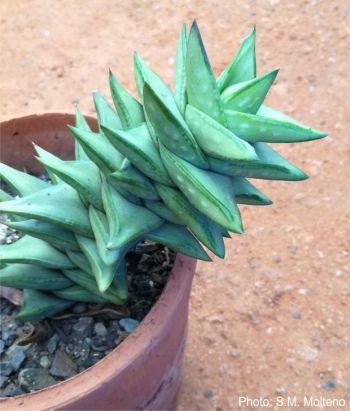
Fig. 12. A specimen of Astroloba tenax var. moltenoi in cultivation in the garden at Babylonstoren in the Western Cape. Photo by S.M. Molteno.
Most species are fairly easy to cultivate, provided they are given a suitable, mineral-rich, very well-drained growing medium and watered thoroughly, but rarely, throughout the year. Most species prefer exposure to bright light, and can tolerate full sun and semi-shade. When grown in full sun, leaves take on interesting reddish colours, while plants grown in shady conditions are greener.
All species can be propagated by either clump-division, stem-cuttings, or from seed. The best time for making cuttings and sowing seed is in spring or summer. Cuttings should be allowed to dry before replanting and can be treated with a fungicide to prevent infection at the cut end. A rooting hormone can also be applied to improve results. Roots can take several weeks to form.
Seed should be sown in a well-drained sandy mixture in shallow trays, covered with a thin layer of sand, and kept in a warm, shaded position to germinate. Take care not to sow seed too close to each other. Seed trays and seedlings can be regularly sprayed with fungicide to prevent rot. Seedlings can be transplanted when they are 2–3 cm tall.

Fig. 13. Seedlings of Astroloba rubriflora at various ages, in a nursery near Barrydale. Photo by S.M. Molteno.
References
- Manning, J.C. & Smith, G.F. 2000. Asphodelaceae: Alooideae. The genus Poelnitzia included in Astroloba. Bothalia 30(1): 53–53.
- Meyer, N.L. & Smith, G.F. 1998. Asphodelaceae: Alooideae: Astroloba corrugata: description of a long-known species in a southern African endemic alooid genus. Bothalia 28(1): 60–62.
- Molteno, S. & Smith, G.F. 2019. The taxonomy and identity of Astroloba spirella (Haw.) Molteno & Gideon F.Sm. (Asphodelaceae: Alooideae), a distinctive species from the western Klein Karoo, Western Cape Province, South Africa. Bradleya 37: 97–111.
- Molteno, S. 2022. Phyllotaxis in Asphodelaceae subfam. Alooideae: a tool in taxon delimitation. Haseltonia 28(1): 59–88.
- Molteno, S., Van Jaarsveld, E.J. & Smith, G.F. 2017. Astroloba robusta P.Reinecke ex Molteno, Van Jaarsv. & Gideon F.Sm. (Asphodelaceae: Alooideae), a new species from the Great Karoo, South Africa. Bradleya 35: 201–211.
- Molteno, S., Van Jaarsveld, E.J. & Smith, G.F. 2017. Astroloba tenax Molteno, Van Jaarsv. & Gideon F.Sm. (Asphodelaceae: Alooideae), a new species from the Groot Swartberg Mountain, South Africa. Bradleya 35: 139–149.
- Molteno, S.M., Smith, G.F. & Figueiredo, E. 2018. A synopsis of Astroloba Uitewaal (Asphodelaceae: Alooideae): species, types, and infrageneric classification. Haseltonia 25: 72–83.
- Smith, G.F. & Meyer, N.L. 2020. Astroloba, Asphodelaceae. In: U. Eggli & R. Nyffeler (eds), Illustrated Handbook of Succulent Plants: Monocotyledons, 2nd ed.: 701–707. Springer, Berlin, Heidelberg.
- Smith, G.F. & Van Jaarsveld, E.J. 2017. Astroloba tenax var. moltenoi Gideon F.Sm. & Van Jaarsv. (Asphodelaceae: Alooideae), a new variety in Astroloba tenax Molteno, Van Jaarsv. & Gideon F.Sm. from the south-central Groot Karoo. Bradleya 35:238–243.
- Smith, G.F., Figueiredo, E. & Molteno, S. 2018. Lectotypification of Astroloba herrei Uitewaal (Asphodelaceae: Alooideae). Bradleya 36: 224–226.
- Smith, G.F., Theron, P.D. & Loots. G.C. 1992. Notes on the microfaunal complement and pollination mechanisms of Poellnitzia rubriflora (Asphodelaceae: Alooideae): an example of mite-flower domatia association. Taxon 41(3): 437–450.
- Van Jaarsveld, E.J. 2015. Astroloba cremnophila, a new cliff-dwelling succulent from the Klein Karoo (Western Cape, South Africa). Bradleya 33: 171–179.
Credits
Ronell R Klopper, Foundational Biodiversity Sciences: SANBI,
Gideon F Smith, Nelson Mandela University
and
Steven Molteno, Molteno Botanical Consulting.
September 2023
Plant Attributes:
Plant Type: Succulent
SA Distribution:
Soil type:
Flowering season:
PH:
Flower colour:
Aspect:
Gardening skill:
Special Features:
Horticultural zones






Rate this article
Article well written and informative
Rate this plant
Is this an interesting plant?
Login to add your Comment
Back to topNot registered yet? Click here to register.